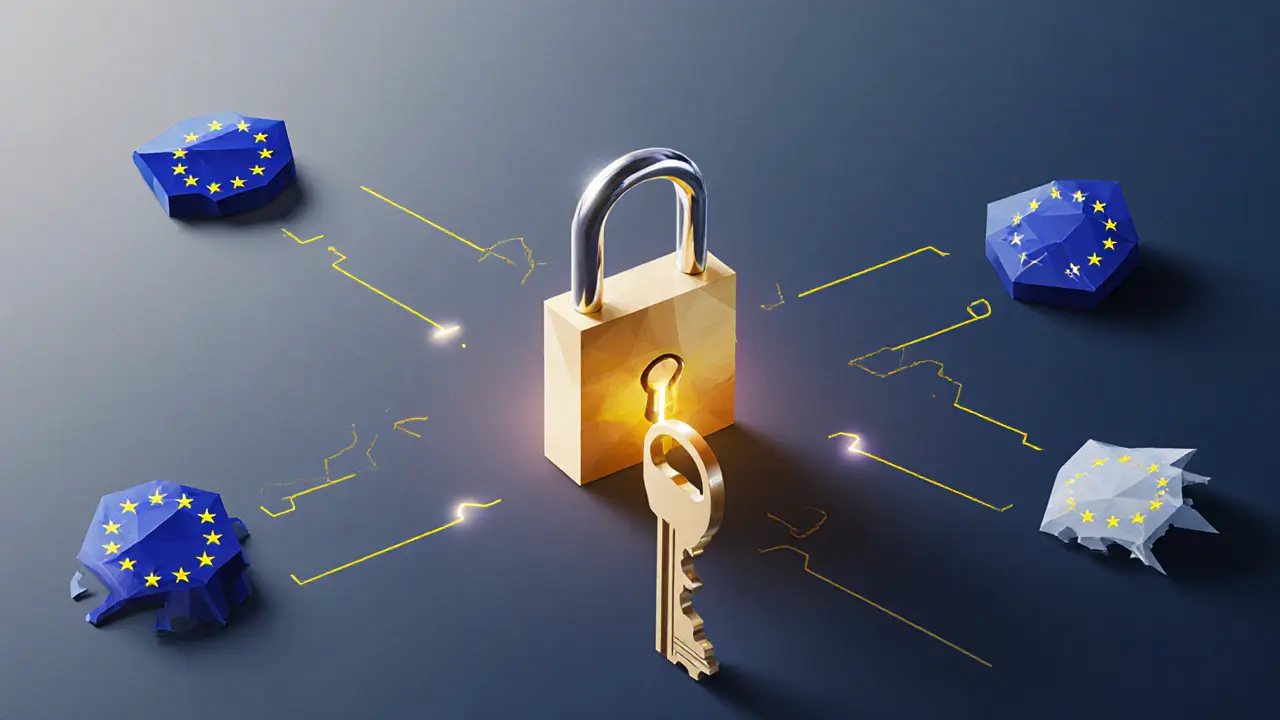Cross-Border Crypto Services in the EU: Understanding MiCA Regulations

MiCA Passport Eligibility Checker
Check Your MiCA Passport Eligibility
What You Need to Know
The EU Passport system allows crypto service providers to operate across all 27 EU member states with a single license. Your eligibility depends on your location and business model.
- EU-Based Providers: Single authorization lets you serve all EU countries.
- Non-EU Providers: Must establish an EU legal entity and get full authorization, except for very limited "reverse solicitation."
- Significant CASPs: Over 15 million EU users require ESMA oversight.
Key Requirements
Before MiCA, running a crypto exchange across Europe was like juggling 27 different rulebooks. Now, with the MiCA regulation in full effect since December 30, 2024, the EU has created a single set of rules for crypto services. But what does this mean for businesses trying to operate across borders?
MiCA is the European Union’s first comprehensive regulatory framework for crypto-asset services. It replaced the messy patchwork of national laws that existed before. Before MiCA, a crypto company needed separate licenses in each EU country to operate there. That was expensive and slow. Now, with MiCA, a single authorization lets you serve all 27 EU member states. This happened in two phases: the first part for asset-referenced tokens (ART) and e-money tokens (EMT) started June 30, 2024. The second part, covering all other crypto services, went live on December 30, 2024.
How the EU Passport System Works
Think of the EU passport system like a driver’s license that works across all EU countries. If you’re a crypto service provider (CASP) based in Germany, you get authorized there. Then you can offer services in France, Spain, or Italy without extra licenses. You just tell your home country’s regulator you want to expand. They notify other countries, and you’re good to go. This saves time and money. For example, a Swiss crypto exchange setting up in Germany only needs one license to serve all EU customers. No more 27 applications.
But it’s not automatic. You must submit specific details to your home regulator, like your business plan and risk management systems. Once approved, your passport is valid for all EU countries. This mirrors rules for banks and investment firms, bringing crypto into the same regulatory family as traditional finance.
What EU-Based Crypto Companies Must Do
Once authorized, EU-based CASPs face strict rules. They need to keep client funds safe. That means holding assets separately from company money, using trusted custodians, or insuring them. For example, if you run a crypto exchange, you can’t use customer Bitcoin for your own investments. You also need to detect market abuse-like insider trading or price manipulation. If you’re a large provider serving over 15 million active users in the EU, you’re a "significant" CASP. That means extra checks from the European Securities and Markets Authority (ESMA).
Anti-money laundering (AML) rules are part of MiCA too. You must check customer identities, monitor transactions, and report suspicious activity. This works with the Anti-Money Laundering Directive (AMLD) to stop crypto from being used for crime. All CASPs need proper insurance and enough own funds to cover risks. If a company goes bankrupt, client assets stay protected.

Rules for Non-EU Companies Serving EU Clients
Non-EU companies face tougher hurdles. If you’re based outside the EU-say, in the US or Singapore-and want to serve EU customers, you must set up a legal entity inside the EU. You can’t just operate remotely. You need full CASP authorization under MiCA. There’s one tiny exception: "reverse solicitation." That’s when an EU client contacts you first without any promotion from your side. But ESMA’s guidelines make this exception very narrow. Most businesses can’t rely on it.
For example, a US-based crypto exchange that markets its services to EU residents through ads or social media must establish an EU subsidiary. If they don’t, they risk fines or being blocked. National regulators in EU countries can also demand full authorization even for cross-border services. This creates uncertainty for foreign firms. Many major exchanges like Coinbase and Binance have already set up EU entities to stay compliant.
How Different Crypto Businesses Are Affected
Not all crypto services face the same rules. Crypto exchanges must register as CASPs and follow strict market conduct rules. Custodial wallet providers-those holding private keys for users-have the same obligations as exchanges. They need to protect client assets and report suspicious activity. Token issuers must publish white papers with clear details about their projects. Stablecoin projects face extra scrutiny. They must prove they can redeem tokens for fiat currency and maintain reserves. For example, USDC issuer Circle had to adjust its reserve management to meet MiCA standards.
As of January 2025, 15 EU countries have shortened the standard 18-month transitional period for local providers. This creates a complex compliance landscape. Some countries require full compliance immediately, while others allow more time. ESMA has issued detailed rules on capital requirements, stress testing, and staff pay policies to help providers adapt. But the cost of compliance is high. Small startups might struggle, while bigger players can absorb the costs more easily.

Current Challenges and Market Impact
MiCA has cleared up regulatory confusion but brought new challenges. Many crypto companies now face higher operational costs. A recent study by the European Central Bank found compliance costs for CASPs have increased by 30-50% since MiCA took effect. Smaller firms worry this favors big players. Yet industry leaders praise MiCA for bringing clarity. The EU is now seen as a global leader in crypto regulation. Countries like Japan and Switzerland are looking at MiCA as a model for their own rules.
ESMA continues to develop technical standards for consistent implementation across member states. National regulators are building coordination tools to supervise CASPs operating across borders. For example, if a German exchange serves customers in Italy, both countries’ regulators share information. This ensures no gaps in oversight. Long-term, MiCA could shape global crypto rules. But as decentralized finance (DeFi) evolves, regulators may need to update MiCA again.
EU vs Non-EU Requirements Under MiCA
| Requirement | EU-Based CASPs | Non-EU Providers |
|---|---|---|
| Authorization | Single authorization in home EU country | Must establish EU legal entity and obtain full CASP authorization |
| Reverse Solicitation | Not applicable | Very limited; only if EU clients initiate contact without promotion |
| ESMA Oversight | Supervised by national authorities | May require direct ESMA reporting for significant providers |
What is the EU passport under MiCA?
The EU passport lets authorized crypto service providers operate across all 27 EU member states with one license. If you’re based in France and get approved there, you can offer services in Germany, Spain, or any other EU country without extra applications. You just notify your home regulator and other countries’ authorities. This saves time and money compared to the old system where you needed separate licenses per country.
Can non-EU companies operate in the EU under MiCA?
Yes, but only if they set up a legal entity inside the EU and get full CASP authorization. Simply serving EU customers from outside the EU isn’t allowed. There’s a narrow exception called "reverse solicitation"-where EU clients contact you first without any promotion. However, ESMA’s guidelines make this exception hard to use for real business. Most non-EU firms must establish EU subsidiaries to comply.
What are "significant" CASPs under MiCA?
A "significant" CASP serves at least 15 million active users annually in the EU. These providers face stricter rules, including direct oversight from ESMA. They need more detailed reporting, stronger risk management, and regular stress tests. This ensures large players don’t pose systemic risks to the financial system. For example, major exchanges like Binance or Coinbase would fall into this category if they hit the user threshold.
How does MiCA affect stablecoins?
Stablecoins face extra scrutiny under MiCA. Issuers must prove they can redeem tokens for fiat currency at any time. They also need to maintain reserves equal to the token supply, with strict rules on where those reserves are held. For example, USDC issuer Circle had to adjust its reserve composition to meet MiCA’s liquidity requirements. This ensures stablecoins stay stable and don’t cause financial instability.
Are crypto wallets regulated under MiCA?
Yes, custodial wallets-those holding private keys for users-are regulated as CASPs. They must protect client assets, report suspicious transactions, and follow AML rules. Non-custodial wallets (where users control their own keys) aren’t covered by MiCA. This means services like MetaMask or Ledger hardware wallets don’t need authorization unless they offer custodial services.

Jenna Em
October 22, 2025 AT 01:16Ever wonder why the powers that be love to hide the truth behind layers of regulation? MiCA looks like progress, but could it be a clever way to funnel crypto control into a single EU overseer? The passport idea sounds convenient, yet it also centralizes power like a hidden hand. What if the real agenda is to monitor every transaction under a single banner? The more we trust a single system, the more we give up our anonymity. It's a subtle trap, disguised as harmonization.
Stephen Rees
October 22, 2025 AT 17:56It feels like we're being handed a golden key while the lock stays hidden. The EU passport may simplify things, yet the underlying networks still watch. One could argue it's a step forward, but the view from the shadows is still there, just less obvious. We should stay cautious and keep questioning the motives.
Katheline Coleman
October 23, 2025 AT 10:36Dear colleagues, the introduction of a unified regulatory framework unquestionably streamlines cross‑border operations for crypto service providers. However, it also imposes a heightened duty of care, particularly concerning asset segregation and AML compliance. I would be grateful if anyone could share practical experiences regarding the implementation of the capital adequacy requirements within their institutions. Your insights would greatly enhance our collective understanding.
Amy Kember
October 24, 2025 AT 03:16Look, the capital rules aren’t just paperwork they’re a real barrier for startups
We need clear templates and fast‑track reviews if the EU wants innovation to thrive
Evan Holmes
October 24, 2025 AT 19:56Too much red tape.
Isabelle Filion
October 25, 2025 AT 12:36Ah, the majestic MiCA regime, a shining beacon of regulatory enlightenment that surely will rescue the crypto wilderness from its own chaos. One must applaud the EU for daring to draft a document so exhaustive that it could double as a bedtime read for insomniacs. The passport system, a marvel of bureaucratic efficiency, elegantly replaces twenty‑seven distinct applications with a single, gloriously cumbersome form. Of course, the expectation that every provider will seamlessly transition ignores the gritty reality of fledgling startups scrambling for compliance capital. The requirement to segregate client assets, while ostensibly protective, is a covert method of inflating operational costs across the board. Meanwhile, the designation of "significant" CASPs for entities serving over fifteen million users introduces an elite class of oversight that would make any regulator's heart flutter. One cannot help but notice the subtle irony that major exchanges such as Binance and Coinbase, historically wary of regulation, now must bow before the very structures they once mocked. The anti‑money‑laundering stipulations, though laudable, add layers of identity verification that border on the invasive, reminiscent of a digital Panopticon. Stablecoin issuers, too, are forced into an intricate dance of reserve verification that could bankrupt the less wealthy innovators. The compliance costs, as reported by the ECB, have surged by a staggering thirty to fifty percent, a figure that certainly raises eyebrows among the profit‑driven. Yet, one must also acknowledge the diplomatic triumph; the EU now stands as a global exemplar, prompting Japan and Switzerland to glance over their shoulders. In the grand scheme, MiCA may very well sculpt the future of global crypto governance, provided it does not become an insurmountable fortress that stifles the very creativity it seeks to regulate. Ultimately, the question remains: will this ambitious framework nurture a vibrant ecosystem, or will it simply replace one set of obstacles with another, more polished but equally restrictive set? Only time, and perhaps a few more regulatory revisions, will reveal the answer.
del allen
October 26, 2025 AT 04:16Wow, that was a lot to take in! 🙌 i totally get both sides – trying to keep us safe but also making it hard for startups 😅 i think if regulators gave some clear guides it could help a lot. hope we see some real help soon! 😊
Jon Miller
October 26, 2025 AT 20:56Man, reading about MiCA feels like watching a drama unfold on a global stage! The EU is trying to be the hero, but the villains are the endless forms and fees. Still, if they pull it off, we could see the crypto world finally get its act together. Can't wait to see how the plot twists next!
Rebecca Kurz
October 27, 2025 AT 13:36Indeed, the narrative is fascinating, but one must remember, dear audience, that every clause-every footnote-carries weight, and the weight, in turn, shapes the destiny of the digital realm; thus, vigilance, patience, and a dash of skepticism are essential, especially when the regulators dance, seemingly, on the strings of unseen puppeteers.
Nikhil Chakravarthi Darapu
October 28, 2025 AT 06:16From my perspective, it is a matter of national pride that the EU is taking the lead; other regions must recognize the importance of sovereign oversight and not allow foreign entities to dominate the market. Strong, precise regulation protects our citizens and our economy.
Tiffany Amspacher
October 28, 2025 AT 22:56Ah, the chorus of regulation sings again, but are we listening to the true melody? Perhaps the EU's grand design will echo across continents, yet the soul of crypto remains untamed, forever seeking the horizon beyond the walls of law.